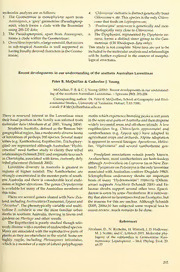Table Of Contentmolecularanalysisareas follows: 4. 'Chlorocomn'cadmariaisdistinctgeneticallyfrom
1. The Geometrinae is monophyletic apart from Chlorocomas.str.ThisspeciesistheonlyChloro-
Anomogeues,a 'grey' geometrine(Pseudopterp- coma thatfeedsonLeptospermiim;
nini), which forms a clade with the Boarmiini 5. 'Pmsinocyma" semicroceaisgeneticallyand mor-
using28SD2data; phologicallyverycloseto Chlorocoma.
2. The Pseudopterpnini, apart from Anomogeues, 6. The Dysphanini, represented by Dysphania nii-
formsa cladewithintheGeometrinae; mana, forms a distinct sister group to the Geo-
3. Oenochlomimperialis,alargeemerald,thatoccurs metrinae (LWRhodopsin data only).
in sub-tropical Austraha is well supported as This study is notcomplete. Moretaxa areyet tobe
havingbasallyderivedcharactersintheGeome- includedinthemolecularanalysisandrelationships
trinae; will be further explored in the context of morpho-
logical structures.
Recentdevelopments in ourunderstandingofthe southernAustralian Larentiinae
PeterB. McQuillan & Catherine Young
J.
McQuillan,F.B.&C.J.Young(2006): Recentdevelopmentsinourunderstand-
ingofthesouthernAustralianLarentiinae.-Spixiana29/3:205-206
Correspondingauthor: Dr. PeterB. McQuillan,SchoolofGeographyandEnvi-
ronmentalStudies,UniversityofTasmania,Hobart;TAS7000;
e-mail: [email protected]
There is renewed interest in the Larentiinae since mothswhichexperiencebreedingpeaksiswetyears
theirbasalpositioninthefamilywasinferred from inthesemi-aridpartsofAustraliaandthendisperse
moleculardata (Abrahametal. 2001,Young2004). widelytocoastalareasandoff-shoreIslands.Afew
Southern Australia, defined as the Bassian bio- eupitheciines (e.g. Chloroclystis approximata) and
geographicalregion,hasamoderatelydiversefauna xanthorhoines (e.g. Epyaxa spp.) have adapted to
oflarentiinesofperhaps200species. Several major agriculturalcropsand orchards. Alpineadaptation
tribes(e.g.Xanthorhoini,Eupitheciini,Trichoptery- isapparentin several lineages: Aponotoreas,Melitii-
giini) are represented although Australian "Hydri- lias, ''Hydriomena" and several xanthorhoine gen-
omenini" need further study to clarify their tribal era.
relationships(Schmidt2001)andenigmatictaxasuch Foodplant associations remain poorly known.
asChaetolopha,associatedwithferns,currentlydefy Aselsewhere,mostxanthorhoinesareherb-feeders
tribalplacement (Schmidt2002). althoughAustrocidariaonCoprosma(asinNewZea-
Larentiine diversity in Australia is greatest in land).TympanotaonPodocarpnsistheonlylarentiine
regions of higher rainfall. The Xanthorhoini are associatedwithAustralianconifers(Dugdale1980).
stronglyconcentratedinthemoisterpartsofsouth- Sclerophyllous understorey shrubs are important
ern Australia and there is considerable local ende- hosts of many "Hydriomenini": Hibbertia (Dilleni-
mismathigherelevations.ThegenusChrysolarentia aceae) Supports Anachloris (Schmidt 2001) and Fa-
isavailableformanyoftheAustralianmembersof baceae shrubs support several other taxa. Epacri-
thistribe. daceaeiseatenbysomePoecilasthena.Itisnotewor-
Thereareseveralgenerashared withNewZea- thythatalmostnolarentiinesfeedonEucalyptus,but
land,includingAiistrocidaria(Tasmania),Epi/axaand the reasons for this areunclear. Although Schmidt
''Anzarhoe".Thephenotypicallyvariableandmulti- (2005, 2006a,b) has subjected some tropical taxa to
voltine E.sidndaria is one the most familiär urban recentreview, muchremains tobedone.
mothsinsouthernAustralia, thrivinginlawnsand
gardensonPlantago and otherweeds.
TheEupitheciini ispoorlystudied though rela- References
tivelydiversewithanumberofundescribedspecies.
Manyareassociatedwiththereproductivepartsof Abraham, D., N. Ryrholm, H. Wittzeil,J. D. Holloway,
plantsastheyareelsewhereintheworld.Someare lMo.gJe.nSycoobflet,heansdubCf.aLmöiflsiteesdtin20G0e1.omMeotlreicdualear(pGheyo--
highly vagile, including Phrissogoniis laücostahis, metroidea: Lepidoptera). - Mol. Phylog. Evol. 20:
whichisamemberofasuiteof(offen)polyphagous 65-77
205
—
Schmidt, O. 2001. The Austrahan species of Anachloris 2006a. Visiaua sordidntn (Moore), a complexofspe-
Meyrick (Lepidoptera: Geometridae: Larentiinae): cies from the hido-Pacific region (Insecta, Lepido-
taxonomy, male genitaha musculature and syste- ptera, Geometridae, Larentiinae). - Spixiana 29:
— maticPosition. -Austr.J. Ent. 40: 219-230 — 77-85
2002. A revision of the genus Chaetolopha Warren Australasian genus Scotocifinn Turner and the re-
(Lepidoptera: Geometridae: Larentiinae) with a cently described species S.siimatrensis Schmidt
description ofParadmetolophn, gen. nov. -Inverte- (Lepidoptera, Geometridae, Larentiinae). - Hete-
— br. Sys. 16: 703-733 roc. Sumatr. 12: 241-255
2003. Someresultsoftaxonomicresearchonlaren- Young, C. J. 2004. Characterisation of the Australian
tiine moths from the Australasian region. -Spixi- NacophoriniandaphylogenyfortheGeometridae
— ana26: 204 from molecular and morphological data. - PhD
2005. Revision of Scoiocyma Turner (Lepidoptera: Thesis, UniversityofTasmania, Hobart
Geometridae: Larentiinae).-Austr.J. Ent.44:,257-
278
Fillingin thegaps: South-Eastern Mountain Grassland as an importantcorridorandrefuge
forMontanePalaeogenicElements within the southernAfricangeometrid fauna
(Lepidoptera, Geometridae)
MartinKrüger
Krüger,M. (2006): Fillinginthegaps: South-EasternMountainGrasslandasan
importantcorridorandrefugeforMontanePalaeogenicElementswithinthesouth-
ern African geometrid fauna (Lepidoptera, Geometridae). - Spixiana 29/3: 206-
207
Dr. MartinKrüger,TransvaalMuseum,NFI, P.O. Box413, Pretoria0001,South
Africa; e-mail: [email protected]
Revisionaryworkonvariousgroupsofmoths,with No trends were observed regarding altitudinal
a focus on Geometridae, since the late 1990's has distribution at subfamily level, and representation
providedsubstantialevidencefortheexistenceofa of Geometrinae, Sterrhinae and Ennominae as a
MontanePalaeogenicElementasdefinedbyStuck- percentage of the species total for southern Africa
enberg(1962)withinthesouthernAfricangeometrid was similar (9.94 to 12.96 %), although Larentiinae
fauna. However,althoughdistributionpatternsfor were more strongly represented (34 species or
severaltaxaarenowwelldocumentedfortheWest- 21.94%ofthetotalforthesubregion).Whenviewed
ern Cape, the Maloti Mountains of Lesotho and in Isolation, the fauna of South-Eastern Mountain
mountainousareasoftheescarpmentfurthernorth, Grassland is characterized by a marked reduction
virtuallynodatafromsuitablehigh-lyingareasthat inGeometrinaeandSterrhinae,withaconcomitant
maysupportthisrelictualfaunahavebeenavailable increase in Larentiinae. Within Ennoniinae, how-
forthevastareabetweentheWesternCapeandthe ever,samplesfromEasternMixedNamaKaroowere
foothills oftheMalotis, representinga gapofmore dominated by Macariini, whereas the diversity of
than500km. Ennomini, Gnophini and especially Nacophorini
A recent sample comprising 141 species ofGe- increased in South-Eastern Mountain Grassland.
ometridae collected in the Sneeuberge (approx. Nacophorinihaveonlyrecentlybeenrecordedfrom
32°10'S 24°55'E), situated in the western part of southern Africa; the tribe remains unsatisfactorily
Eastern Cape Province, South Africa at altitudes definedbutisprobablybasalwithinEnnominaeand
between 993 and 1618m, was analyzed for trends almost entirely limited in its distribution to the
incompositionaccordingtoaltitudeand/orVegeta- former Gondwanan continents Australia, South
tion type. (The highest peak in the area reaches America and southern Africa.
2122mbutareasabove1618mcouldnotbesampled Aswouldbeexpectedfromitsbeingcontiguous
duetodifficultyofaccess.) Above 1600m, thearea toAlti-MountainGrassland,oneofthetwodominant
isoccupiedbyasoutherlyextensionofSouth-East- high-altitude veld types in Lesotho, in the eastern
ernMountainGrassland (grasslandbiome),where- part of its ränge, the montane moth Community
asthelower-lyingareasfallintothesemiaridEastern dependentonSouth-EasternMountainGrasslandis
Mixed Nama Karoo (Nama Karoo biome), a semi- OverallmoresimilartothatoftheMalotirängeand
arid veld typeecotonal tograssland. adjacentmontaneareasthan tothatoftheWestern
206

